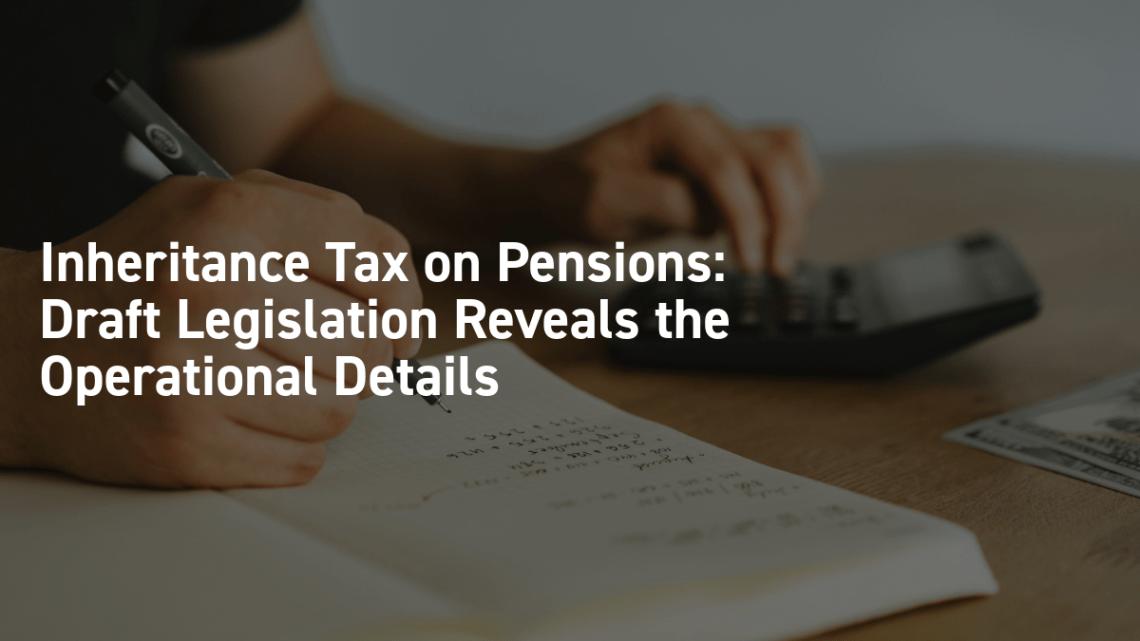
Following our article from January this year looking at the Government’s announcement to bring pensions within the inheritance tax (IHT) net from April 2027, the Treasury has now released draft legislation that reveals how these changes would work in practice. These practical specifics will impact how families and advisers need to prepare for the new regime.
A Shift in Responsibility
One of the most significant revelations in the draft legislation concerns who will actually be responsible for paying the tax. Originally, pension scheme providers were expected to bear some responsibility, but the draft bill places the burden squarely on personal representatives (PRs).
This represents a fundamental shift in how pension death benefits will be administered. PRs will have primary responsibility for the IHT liability, but they are entitled to be reimbursed by the beneficiaries inheriting the pension. There will be a mechanism allowing beneficiaries to request, and in certain circumstances require, the pension scheme administrator to pay the IHT direct to HMRC from the pension assets.
The Process
The draft legislation reveals a structured four-step process that will govern how these changes operate:
Step 1: Notification and Appointment – PRs must inform pension scheme administrators of their appointment following the member’s death.
Step 2: Valuation and Classification – Administrators have four weeks to provide PRs with the value of all death benefits and identify whether funds will be distributed to exempt beneficiaries (typically spouses and civil partners) or non-exempt beneficiaries.
Step 3: Tax Calculation and HMRC Notification – PRs use the valuation information to calculate any IHT liability and notify HMRC accordingly.
Step 4: Beneficiary Communication Scheme – Administrators must inform beneficiaries of their potential IHT liability and explain the various payment options available.
Important Exclusions Confirmed
While the broad principle of bringing pensions into IHT remains unchanged, the draft legislation confirms several important exclusions that weren’t clear in the original announcement:
These exclusions address practical concerns raised during the consultation period about the impact on bereaved families’ immediate financial security.
Timing Pressures and Practical Challenges
The six-month payment deadline, calculated from the end of the month in which the member dies, creates particular challenges that weren’t immediately apparent from the original announcement.
Self-administered pension schemes holding illiquid assets such as commercial property or private company shares will face significant difficulties in meeting this timeline. The combination of higher interest rates on unpaid tax and the complexity of valuing and potentially disposing of illiquid assets creates a perfect storm of time and financial pressure.
Many trustees of such schemes may need to consider their investment strategies well before 2027 to ensure sufficient liquidity for potential IHT liabilities.
Relief from Double Taxation, But Not Elimination
Where the total size of the estate is over the IHT threshold, pensions will be liable for 40% IHT followed by an Income tax bill for drawing the remaining benefits if the original pension holder died after the age of 75.
The draft legislation confirms that income tax will not apply to the portion of death benefits corresponding to any IHT paid. This provides some relief from the double taxation concerns we highlighted in our earlier analysis but doesn’t eliminate the overall tax burden.
HMRC will establish mechanisms allowing beneficiaries to reclaim excess income tax where applicable, but this adds another layer of administrative complexity to an already intricate process.
Looking Ahead
The operational complexity revealed in the draft legislation means that advisers need to start preparing clients well before April 2027. Key considerations include:
For clients with significant pension wealth, the interaction between these new rules and existing estate planning strategies needs urgent review. The traditional advice to preserve pension funds for inheritance purposes may need fundamental reconsideration.
For trustees of self-administered schemes, investment strategy reviews should consider liquidity requirements for potential IHT payments, particularly where schemes hold illiquid assets.
For clients approaching retirement, the balance between pension drawdown timing and inheritance tax planning has become significantly more complex and will require sophisticated modelling of different scenarios.
While April 2027 may seem distant, the complexity of the new administrative processes means that preparation needs to begin now. The draft legislation shows that this isn’t simply a matter of adding 40% tax to pension inheritances; it’s a fundamental restructuring of how pension death benefits are administered and taxed.
Professional advice will be essential not just for tax planning, but for navigating the administrative maze that these changes will create.
We’d love to hear from you. To book an appointment or to find out more about our services: